Your wedding ring is something you’ll most likely want to wear every day. Choosing the right metal can make a difference as to whether you can or not.
It’s something that’s often overlooked by jewellery buyers, especially if you’re not a frequent purchaser. But if you don’t choose the metal for your everyday rings wisely, they won’t be comfortable to wear. Nor will they last the distance.
Here are seven questions you (and your partner) need to ask yourselves when choosing the right metal for your rings.
Question #1: What’s my wedding ring budget?
When it comes to rings made from precious metals, you can spend a few hundred dollars or you can spend thousands. Like most things, your budget determines what you can and can’t have.
That raises the question; How much does metal choice affect cost?
For simplicity, we’ll use plain, machine-made and hand-polished wedding bands as our example. The table below gives you a real-world example of what difference your metal choice makes. (We mostly supply handmade rings, but there are too many variables in the bespoke arena to consider to make a meaningful comparison.)
The prices* listed are for a ring of the same size and design – a 6mm wide Australian size T (US 9 2/3) 1.5mm thick.
Style-wise the example ring is a half-round profile, comfort fit with a polished finish, made with recycled metal.
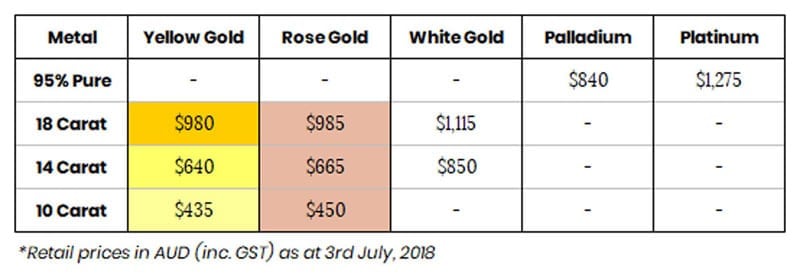
As you can see, a platinum ring can be almost three times the cost of a 10 carat** gold ring of the same size and design.
Your choice of metal can make a big difference to cost, but when you get to the ‘heirloom-quality’ end of the market (18 carat gold and platinum), the gap between the two is smaller.
**10 carat is a US carat weight. We use nine carat in Australia.
Finger size matters
The bigger your finger, the more metal that’s needed to make a ring to go around it. What that means is your budget might limit your choice of metals depending on your finger size.
Using the same style of wedding ring as in the table above, if you have a larger finger, say, Aust-size X3/4 (US-size 12), a platinum ring to fit would cost around AUD$1,350 retail (at the time of writing), whereas a machine-pressed palladium ring in the same size would be around AUD$1,050 retail.
In other words, your budget might cause you to choose palladium rather than platinum. The reality is that if you have a larger finger, you are likely to want a wider, and possibly thicker band. This will cost even more.
Please note, the prices stated here are not for handmade rings. These are simple, machine pressed rings with no diamonds or engraving or fancy textures. A price guide for bespoke rings can be found here.
Question #2: Will the ring be worn alone or with another ring?
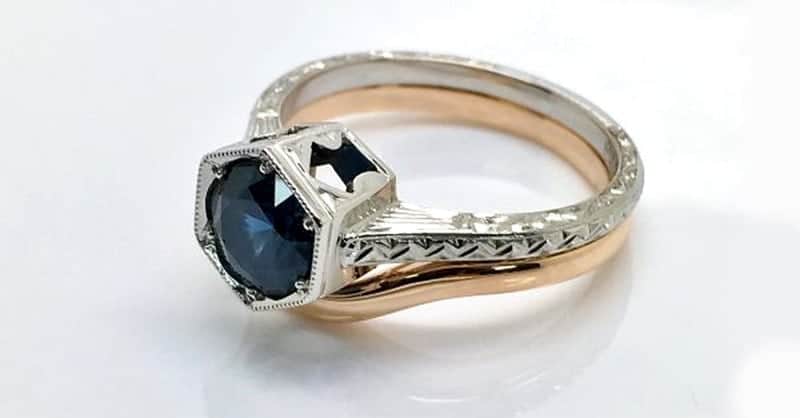
This question relates to how different metals wear over time.
Platinum is the strongest and hardest wearing of the mainstream jewellery metals and has the tendency to displace (with regular wear, not brute force) rather than erode.
Gold, however, will wear away over (a long) time.
This is something that you will notice when looking at very old rings, particularly mixed metal engagement-style rings.
You’ll see the platinum claws are often still intact, but the gold band is usually almost worn away, or at least very thin at the base.
18 carat yellow gold is the softest of the ring metals most commonly used in our handmade rings.
If you’re planning to wear two rings together, generally it’s best to put like with like. Gold with gold, platinum with platinum, etc.
That said, it is popular to mix precious metals – most often rose gold and platinum. This is a beautiful look and we wouldn’t discourage it altogether.
The only time we would suggest a rethink is if you were considering a diamond set gold wedding band next to a platinum engagement ring. If you wear a platinum ring beside a gold ring, the platinum ring can cause the gold to wear away faster than if it were paired with another gold ring.
As it’s always our preference to create heirlooms, we’ll always advise against doing something that will reduce the lifespan of something we’ve made for you.
Question #3: What colour metal do I want?
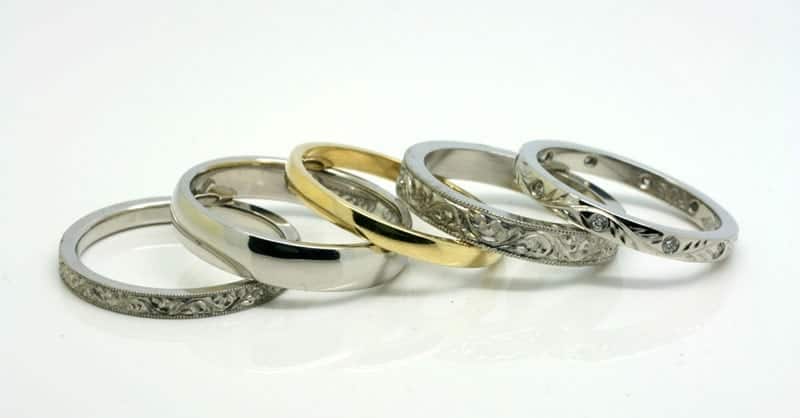
When it comes to colour, there are three mainstream choices – white, rose and yellow.
Yellow gold ranges from vivid (18 carat) to soft yellow (9-10 carat).
The white metals (white gold, palladium and platinum) can range from a darker silver colour (un-plated white gold) to very bright white. Either rhodium-plated white gold or palladium.
If you’re not familiar with it, rose gold is a warm, pinky-red.
Colour comes down to personal preference.
If you like white metal, you have choices to make based on budget, lifestyle and skin reactivity.
If you like yellow or rose, you are limited to carat choices.
Question #4: Is your wedding ring going to have a ‘hard life’?
Some wedding rings have it easy, rarely encountering anything very abrasive. Other wedding rings are far more challenged.
Some are squeezed against a bicycle handlebar grip for hours at a time. Some are worn during workouts in the gym, while gardening or get dragged through sand while building sandcastles. Others are worn on building sites, while fixing cars or spend their days on a surgical ward being washed constantly***.
If your wedding ring is going to have a hard life, choose one or other of the extremes. Platinum because it’s not as malleable as 18 carat gold and palladium. Or choose 9 carat gold because it’s (relatively) lower cost, harder and more difficult to bend out of shape.
By the way, all metals get scratched! If your wedding ring is going to have a hard life, it’d be wise to choose a design with a matte finish, lots of texture or engraving to hide the inevitable scratches.
***A note to those in the medical profession, or anyone who has to frequently use medical grade handwash. Palladium is not a good metal choice as it can become discoloured by the handwash.
Question #5: Is my skin sensitive to jewellery metals?
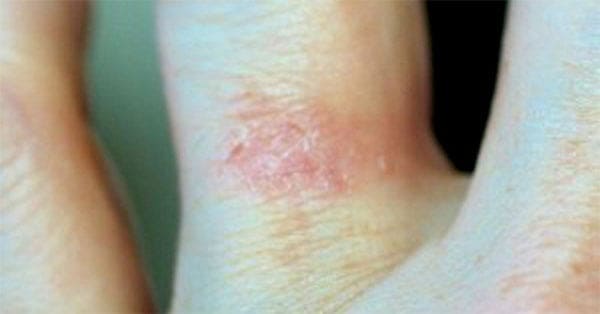
The most frequent cause of allergic reactions is nickel. This is most commonly alloyed with white gold. (Other common metals alloyed with gold are palladium, copper and silver.)
As a guideline, the Jewellers Association of Australia recommends the following:
- A piece of jewellery that will be in close contact with external surface of the skin (such as a ring, bracelet or necklace) should be no more than 3% nickel.
- A piece of jewellery that will be in contact with internal skin – like an earring or belly ring post – should contain no more than 0.05% nickel.
As both are hypoallergenic, platinum and palladium are your safest choices if you or your partner suffer skin reactions to jewellery.
If you must have white gold, insist on a nickel-free gold alloy. Rest assured, if you work with us, we do not use white gold with nickel content.
To learn more about skin sensitivity have a look at this article.
Question #6: How likely am I to lose my ring?
If you’re already a ring-wearer, you’ll know that sometimes your rings are easier to get off than at other times. That might be due to a change in body weight, but more often it’s because of a change in ambient temperature.
People’s hands and fingers tend to swell a little in hot weather and shrink a little when they’re cold.
If you’re an active, outdoors person (particularly if you’re into water sports like swimming, surfing or sailing) your body extremities are often going to get very cold. When this happens, your fingers can shrink, and it becomes much easier to accidentally lose a ring.
If you think that’s a real risk, then you might be best to choose a lower cost metal for your wedding ring like 9 carat gold (or palladium if you suffer skin reactions). So if you do happen to lose it, it won’t break the bank.
Either way, if this is a potential problem, it’s best to remind yourself to remove the ring (and put it somewhere safe) or tape your finger well before you go.
Question #7: Am I making an ethical choice?

What does that mean when it comes to precious metals? Simply put, ethical metal is metal that is sourced in a way that does the least harm to people and the environment.
Precious metals typically come from one of three sources:
- Large-scale mining – which can cause environmental and social harm to lesser or greater degrees depending on the nation of origin;
- Artisanal Small Mining – seek out fair-mined. Corruption, exploitation and child labour is still a major problem in small scale mining, especially in developing countries; and
- Recycled – from old jewellery, electronic goods, jeweller’s waste, the motor vehicle industry and more. Seek out suppliers who adhere to environmental protection guidelines.
As far as we’re concerned, the most environmentally friendly choice is recycled metal (provided it’s from a responsible refiner).
But we also recognise the economic value of fair mined gold to developing countries and can offer them as well. Importantly, recycled and fair-mined precious metals are readily available in Australia, so don’t let your jeweller tell you otherwise.
If you would like to learn more about the global supply chain for precious metals, we’ve written two articles on the subject. One about gold and the other about the platinum group metals.
As you can see, there are many things that can affect your choice of precious metal for your wedding rings. We hope we’ve given you some useful things to consider to help you make the best choice for your own wedding, commitment or other significant ring.
Learn more
If you’d like to learn more about engagement and wedding ring design, you’re welcome to download our comprehensive guides on the subject.
Contact us
If you’d like to get in touch to discuss your jewellery needs, email us at [email protected] or in Australia phone: 07 3379 2596
About EJA
Ethical Jewellery Australia is an online engagement and wedding ring specialist. Every ring is custom designed and made to order.
We take our customers through the whole process from design to sourcing and finally to manufacturing.
All rings are handmade in Australia with recycled metals. (We can also supply Fair Trade gold if requested.)
Likewise, we only every use ethically sourced diamonds and gemstones. You can choose from Argyle, recycled, vintage and lab-grown diamonds, Australian, US, Fair Trade, recycled and lab-grown coloured gemstones.
By the way, we offer an Australia-wide service.
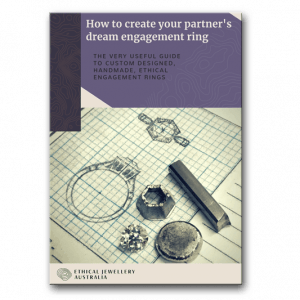 If you would like to learn how to start your engagement ring design adventure, get in touch today.
If you would like to learn how to start your engagement ring design adventure, get in touch today.
Or if you’d like to start by learning more about designing an engagement ring, download a free copy of our 70+ page design guide.
About the Author: Benn Harvey-Walker
 Benn is a Co-founder of Ethical Jewellery Australia and a keen student of ethical and sustainability issues in the jewellery world. He has a long history in sales and marketing and began working with EJA full time in early 2018.
Benn is a Co-founder of Ethical Jewellery Australia and a keen student of ethical and sustainability issues in the jewellery world. He has a long history in sales and marketing and began working with EJA full time in early 2018.
Benn co-authored the original Engagement Ring Design Guide in 2014 and edited the 2nd Edition in 2018. He is also the principal author of our wedding and commitment ring design guide.
His main responsibilities at EJA are business development and sales process management. Benn also creates technical drawings for our ring designs.

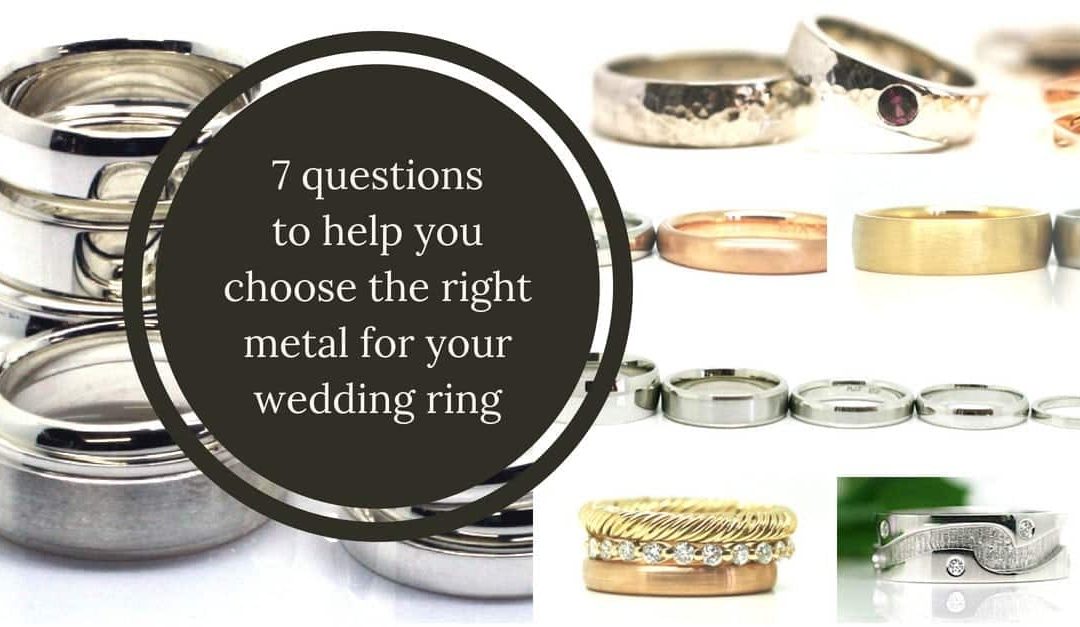
Recent Comments